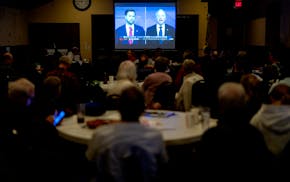Laura Kalambokidis has the kind of job at the Capitol where many in the building absorb her every word in a way that even a governor would envy.
The new state economist's most high-profile work is helping create the state's twice-annual economic and budget snapshot, an 80-page report that dissects and analyzes every arcane nook of the state economy, from agriculture to housing starts to the latest political kerfuffle in Washington.
Kalambokidis is the first new state economist in nearly three decades, replacing the now-retired Tom Stinson.
Her work serves as the underpinnings of the state budget forecast, which locks in the state surplus or a deficit for the rest of the budget cycle. That number becomes gospel around the Capitol.
Figuring out the state's economic landscape requires an obsessive attention to myriad details.
"I am trying to pay attention in the real economy and what actual taxpayers are doing," said Kalambokidis, 50, who lives in Stillwater. "This position has pushed me more in the direction of not just what the theoretical models tell us. What are the workers saying? What are the families saying? What are the businesses saying?"
With so much at stake in her analysis, Kalambokidis has to be painfully careful in what she says or how she characterizes things. In the weeks leading up to the economic forecast, she goes into what Minnesota Management and Budget officials call the "cone of silence." That means no talking to legislators, journalists — not even to the governor.
There's a lot at stake in the accuracy of the forecasts. Wild swings in deficits or surpluses can create political havoc, forcing state leaders to cut too deeply or sit on too much taxpayer money. That can make consumers, voters and businesses uneasy.
"The hardest part is keeping track of a wide range of topics and issues that can change quickly," she said.
That means paying close attention to agriculture industry, how tax payments are rolling in and tax policy in surrounding states. Lately, Kalambokidis has watched with increasing interest the explosive growth in the North Dakota oil fields and how it is reshuffling the region's economy.
"That is the fascinating part of the job and helps me stretch all of my economics muscles," she said.
Kalambokidis splits her time between her work at the state and a faculty position at the University of Minnesota, where she specializes in public-sector economics and tax policy.
Now she must take her academic expertise and pair it with real-world data when shaping the economic forecast.
"We are constantly scanning the data and the information coming in," Kalambokidis said.
This is where forecasting can become a curious mix of art, science and questioning.
Sometimes Kalambokidis hears things anecdotally from Minnesotans or business leaders that does not mesh with the data.
"I have to step aside for a moment and say, 'Where am I hearing this from? Is it giving me a clue about something I have overlooked?' "
But the trick is not placing too much weight on individual stories, but rather using them to lead to what might be a deeper truth.
"We have to be gut-checking that," Kalambokidis said. "It's a challenge. But we use the anecdotes as clues."
Kalambokidis is still emerging from the shadow of Stinson, who held the job for 26 years and served administrations of all political stripes.
"He knew everything," she said. "I am trying to replicate his success as much as possible."
Minnesota Management and Budget Commissioner Jim Schowalter said Kalambokidis is acutely aware that she is replacing "the legend."
"She both wants to do no harm and make it better," Schowalter said. "That's a tough line to walk."
Former DFL Senate Majority Leader Kari Dziedzic dies of cancer at age 62

How the Star Tribune is covering the 2024 election

Fact check: Walz and Vance made questionable claims during only VP debate

In Tim Walz's home city, opposing groups watch him debate on the national stage

